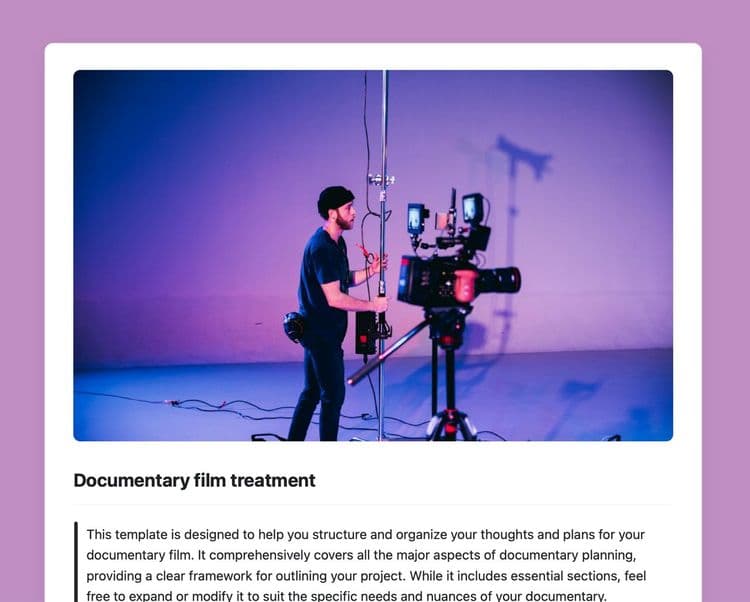Taking your film from concept to creation is a process that demands a keen understanding of your story and a clear way to share that understanding with the world. A director's treatment is an invaluable tool for achieving this goal. It's a document that outlines how a director plans to approach and realize a project. This document typically includes the director's vision, tone, style, approach to storytelling, visual look, and sometimes even specific shots or sequences they have in mind. The treatment might also touch on themes, character arcs, and how the director intends to work with actors.
Our director’s treatment template is a comprehensive guide that walks you through the essential components of pre-visualizing your film or media project. We have designed it to help bring the key details of your vision to the forefront for collaborators, stakeholders, and your production team. Each section is carefully crafted to help you outline your creative process, from the gripping logline that ensures your story sticks, to the deep dive into the psyche of your characters.
Benefits of a director's treatment template:
- Structure and clarity: A template offers a structured format for presenting ideas. This helps in organizing thoughts and ensuring that all the key elements of the director's vision are communicated clearly.
- Efficiency: With a template, directors can save time on formatting and focus more on the creative aspects of their treatment. It's a starting point that can be customized for different projects.
- Persuasiveness: A well-organized treatment that follows a proven template can be more persuasive, as it demonstrates professionalism and a clear vision, which are crucial for securing funding or greenlighting a project.
- Collaboration: A standardized template can facilitate collaboration among various departments and production team members who may need to contribute to or understand the treatment.
- Refinement: The process of filling out a template can help directors refine their vision, as it forces them to think through and articulate each aspect of the project.
Key sections of the director's treatment template
Our template includes the following sections designed to help you give a thorough account of your project:
- Logline: This is your opportunity to reel in your audience with a single, captivating sentence.
- Synopsis: In the Synopsis, you’ll flesh out the story further, introducing the key plot points and the world they take place in.
- Vision statement: The Vision Statement is a personal letter from you to the reader, revealing the connection between you and your story.
- Tone and style: This section sets the expectation for how your story feels, not just what happens.
- Themes: This is your chance to show the depth and thoughtfulness beneath your story’s surface.
- Characters: This section encourages you to delve deep into your characters, as well as their journeys, motivations, and flaws.
- Visual style: Talk about your approach to cinematography, color schemes, and production design, painting a picture of the visual journey you have planned.
- Sound and music: This portion of the template is where you’ll detail the auditory elements of your film, from the score to the subtle sounds that give your film texture.
- Requirements and resources: A chance to outline what you need to turn your vision into reality. From budget outlines to necessary equipment, it’s a roadmap to your project’s practicalities.
- Target audience and comparative films: This section helps you to identify and understand the viewers who will find your story compelling. You’ll also reflect on what you can learn from similar successful projects.
- Director’s experience: This is where you can build credibility and trust, showing potential collaborators and funders why you’re the best person to bring this story to the screen.
Why not try our director’s treatment template to ensure your vision is communicated effectively? Fill in the blanks with your unique concepts, and step forward confidently towards bringing your vision to the screen.





